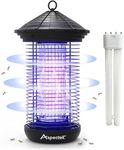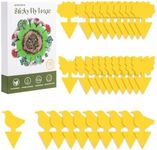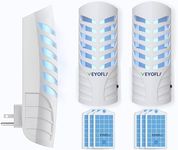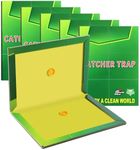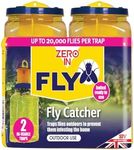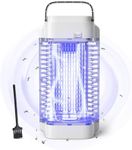Buying Guide for the Best Fly Traps
Choosing the right fly trap can make a significant difference in managing pests effectively. Fly traps come in various types and designs, each suited for different environments and needs. Understanding the key specifications will help you select the best fly trap for your situation.Type of Fly TrapFly traps come in several types, including sticky traps, electric traps, bait traps, and UV light traps. Sticky traps use adhesive surfaces to catch flies, electric traps use a grid to electrocute them, bait traps lure flies with attractants, and UV light traps attract flies with ultraviolet light. The type of trap you choose depends on where you plan to use it and the severity of the fly problem. For indoor use, UV light traps and electric traps are often preferred for their cleanliness and effectiveness. Sticky traps and bait traps are more suitable for outdoor use or areas with heavy fly infestations.
Coverage AreaThe coverage area indicates how large of a space the fly trap can effectively manage. This is usually measured in square feet or meters. Smaller traps are suitable for individual rooms or small areas, while larger traps can cover extensive outdoor spaces or large indoor areas. Consider the size of the area where you need fly control. For a small kitchen, a trap with a smaller coverage area will suffice, but for a backyard or a large warehouse, you will need a trap with a larger coverage area.
Power SourceFly traps can be powered by electricity, batteries, or be non-powered. Electric traps need a power outlet, making them ideal for indoor use where outlets are readily available. Battery-powered traps offer more flexibility and can be used in areas without access to electricity. Non-powered traps, such as sticky or bait traps, do not require any power source and can be placed anywhere. Choose a power source based on the location and convenience. If you need a trap for an outdoor picnic area, a battery-powered or non-powered trap might be more practical.
Ease of MaintenanceMaintenance involves cleaning and replacing parts of the fly trap. Some traps require frequent cleaning and replacement of sticky pads or bait, while others, like electric traps, may need less frequent maintenance. Consider how much time and effort you are willing to invest in maintaining the trap. If you prefer a low-maintenance option, electric traps or UV light traps might be better. For those who don't mind regular upkeep, sticky traps and bait traps can be effective.
Safety FeaturesSafety features are important, especially if you have children or pets. Look for traps with protective grids to prevent accidental contact with electric parts, non-toxic bait, and secure housing to avoid any hazards. Safety features ensure that the trap is safe to use in various environments, including homes with kids and pets. If safety is a concern, prioritize traps with robust safety features to prevent any accidents.
Environmental ImpactConsider the environmental impact of the fly trap. Some traps use chemicals or pesticides that can be harmful to the environment, while others use non-toxic methods like UV light or adhesive surfaces. If you are environmentally conscious, opt for traps that use eco-friendly methods to catch flies. This is particularly important for outdoor use where chemicals can affect other wildlife and plants.


